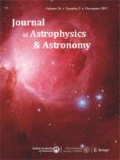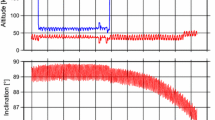Abstract
The data pipeline at the Payload Operation Centre (POC) of the Scanning Sky Monitor (SSM) onboard AstroSat involves: (i) fetching the Level-0 data from the Indian Space Science Data Centre (ISSDC), (ii) Level-0 to Level-1 data processing followed by Level-2 data generation, and (iii) transfer of the Level-1 and Level-2 data back to ISSDC for dissemination of the re-packaged Level-2 data products. The major tasks involved in the generation of Level-1 and Level-2 data products are: (a) quality checks; time, alignment corrections, (b) temporal-HK plots generation, and, (c) image processing; light curve generation. The typical turn around time for this fully automated pipeline is about 25 min for one orbit data. In this paper, details of all the stages of this data pipeline are discussed.










Similar content being viewed by others
Notes
The non-standard MAXI product of 2.5–10 keV light curve is generated using the MAXI on-demand Process at http://maxi.riken.jp/mxondem/.
References
Agrawal P. C. 2006, Adv. Space Res., 38, 2989
Libes D., O’Reilly T. 1995, Exploring Expect: A Tcl-based Toolkit for Automating Interactive Programs (O’Reilly Media Inc.)
Love R. 2005, Linux J., 2005, 8
Matsuoka M., Kawasaki K., Ueno S. et al. 2009, Publ. Astronom. Soc. Japan, 61, 999
Pence W. 1999, in Mehringer D. M., Plante R. L., Roberts D. A., eds, Astronomical Society of the Pacific Conference Series, Vol. 172, Astronomical Data Analysis Software and Systems VIII, 487
Ramadevi M. C., Seetha S., Bhattacharya D. et al. 2017, Exp. Astron., 44, 11
Ravishankar B. T., Bhattacharya D. 2003, BASI, 31, 491
Singh K. P., Tandon S. N., Agrawal P. C. et al. 2014, in Takahashi T., den Herder J.-W.A., Bautz M., eds, Society of Photo-Optical Instrumentation Engineers (SPIE) Conference Series, Vol. 9144, Space Telescopes and Instrumentation 2014: Ultraviolet to Gamma Ray, 91441S
Acknowledgements
The authors are thankful to the anonymous referee for her/his very useful suggestions and comments which have helped to improve the quality of the manuscript. This research has made use of MAXI data provided by RIKEN, JAXA and the MAXI team. BTR, SV, MCR and AS thank GH of SAG, DD of PDMSA, and Director, URSC for encouragement and continuous support to carry out research and project work.
Author information
Authors and Affiliations
Corresponding author
Additional information
This article is part of the Special Issue on “AstroSat: Five Years in Orbit”.
Rights and permissions
About this article
Cite this article
Ravishankar, B.T., Vaishali, S., Bhattacharya, D. et al. AstroSat/SSM data pipeline. J Astrophys Astron 42, 56 (2021). https://doi.org/10.1007/s12036-021-09729-z
Received:
Accepted:
Published:
DOI: https://doi.org/10.1007/s12036-021-09729-z




